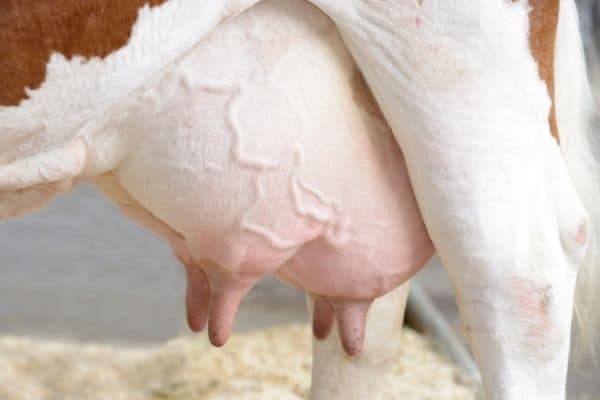Milk is one of the most popular daily purchases worldwide and in the U.S. In fact, the average American consumes nearly sixteen ounces per day. However, while milk is a product we consume every day, we don't often stop to think about the cows who produce it and just how much milk an udder can hold.
On average, a single cow's udder can hold 3-6 gallons of milk at one time. However, this figure is subject to change depending on several factors, such as the cow's size, health and genetics, overcrowding at the feeding bunk, year and season of calving, age, breed, stage of lactation, milking frequency, and living conditions.
Want to learn more about how much milk cows produce and the factors that impact dairy production? This article aims to get you up to date with all the recent dairy farm lingo, stats, and terminology.
How Much Milk Can a Cow's Udder Hold?
A single dairy cow's udder can hold between 3 to 6 gallons of milk at a time. On average, they can produce around 8.39 gallons or 134 cups of milk per day.
Dairy farms can have anywhere from 200-15,000 cows, with the average size being between 1000-1500; the approximate total number of dairy cows in the U.S. is 9.34 million. That means the daily average of milk production in the United States alone is around 78,362,600 gallons or 1,251,560,000 cups of milk per day!

What Factors can Affect Milk Production?
However, these numbers are based on the assumption that every cow is producing what is expected, which isn't always the case. Many different factors can affect cows, causing them to overproduce or underproduce milk. Some of the most common factors that can result in decreased milk production are:
Anatomy of a Dairy Cow's Udder
In every dairy cow, the udder is divided into four sections called quarters. Inside and toward the top of each quarter are sacs called alveoli where the milk is produced. Connected to and beneath the alveoli are the gland cisterns known as the udders' storage area. The gland cisterns lead down to the teats, where the milk exits the udder once the alveoli have been stimulated to produce milk.
How Many Teats Does an Udder Have?
Although cows, regardless of breed, generally have four teats on each udder quarter, it is not unheard of for them to have more than four. In fact, nearly 50% of domesticated cows have extra teats, which are also known as supernumerary teats. The supernumerary teats rarely produce milk, and if they do, it is so small an amount that it has virtually no effect on the amount produced.
On the flip side, sometimes an udder quarter will have less than four teats. This is a much less common occurrence than supernumerary teats and is caused by one of three things:
- 1The cow developed in utero without the fourth teat.
- 2The teat was bitten off by another calf.
- 3The cow originally had four teats, but two of them were spaced so closely together that they fused into one teat.
Signs of a Good Udder and Bad Udder
There are some signs to look out for to make sure that udders will be healthy and productive. As mentioned above, sometimes there will be teat spacing issues where the teats grow so closely together that they will fuse. This can cause serious problems, both with calves not getting enough milk and the cow being milked by hand or machine.
The following are other signs you should look out for to determine whether a cow's udder is healthy or not:
Good Udder | Bad Udder |
|---|---|
Teats are the same size and length | Teat sizes are irregular |
Teats are pointing slightly inward (when full) or toward the floor (when emptied) | Teats are pointing out |
Four teats | Less than four teats-can lead to underproduction of milk and the udder drying up completely |
The rear two udders are the same size | The rear two udders are different sizes |
Udder skin is soft and pliable | Udder skin is rough and unyielding |
Large mammary veins | Small mammary veins |
Threats to Udder Health
The most common issue threatening udder health is mastitis. Mastitis occurs when a milk duct is clogged, causing an infection that can lead to inflammation, pain, fever, and depression. Wateriness, flakes, or clots in the milk are an indication that the cow may have mastitis and need antibiotics.
The two sources of mastitis in cows are:
How Much Milk Can Remain in the Udder?
Since cows need to be milked regularly to reduce the risk of mastitis, is it okay for any milk to be left in the udder?
There are different opinions on this, with some people thinking the udder should be emptied. However, the most recent opinions say that it is actually safer for the cow to have some milk left in the teat so, it does not overproduce, which could lead to blockage and infections.
The safest amount to be left in the teat is one cup. You can measure this out using a strip yield test or with a milking unit.
Also Read: Do Cows Feel Pain When Milked?
Hand vs. Machine Milking
While some dairy farms are so large, there is no choice but to use milking machines, but if you have enough workforce or have a small enough farm where time is not as big of an issue, it is better for the udders to be milked by hand.
There is less of an issue with bacteria being passed from one cow to another from hand milking, which can spread around mastitis bacteria. The cow udders are also not emptied completely, which would otherwise lead to overproduction and, again, mastitis and other kinds of infections.
Milking by hand also gives the farmer the chance to get to know the cows individually, and they will be more sensitive to any changes in the cow or when they notice something may be off, so they can get help before things get bad.
Final Thoughts
Dairy cows are an important part of life in the United States, providing millions of gallons of milk (and yogurt and cheese) per year. As such, it is vital to make sure that they are in the best of health. The most important way to do so is to monitor and take care of their udders' health.
This can be done in various ways, including making sure their living conditions are clean, that they have plenty of space, and making sure they are milked often—but not too often. Observation and care can ensure that your cows remain healthy and productive for years.
